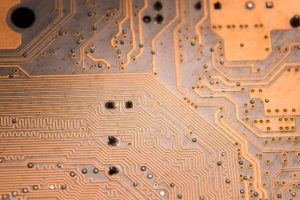Ever wondered how multilayer printed circuit boards maintain optimal transmitting signals between their layers? The secret is printed circuit board (PCB) etchback. This technique, used specifically with plated through-hole (PTH) procedures, involves producers adding a copper coating to the interior sides of the via. This helps PTH boost conductivity by seamlessly connecting the circuits.
But how is etchback created? What processes are involved in its buildup? We’ll answer these questions and more in this comprehensive overview of PCB etchback.
What’s the Purpose of PCB Etchback?
PCB etchback removes epoxy resin from the sides of drilled via holes to maintain electrical conductivity between layers, especially when these holes are electroplated. For certain high-reliability applications, the IPC-6013 standards specify the necessary copper exposure.
In the micro-etch process, manufacturers immerse or spray the base laminate and then drill through-holes into the multilayer PCB. A subsequent plasma etch clears away unwanted smears and dielectric particles in a step known as de-smearing.
Following this, de-smearing combines with PCB etchback. This combination etches into a plated via hole and extends copper layers, improving the PCB’s electrical connectivity. By doing this, PCBA manufacturers can plate three sides of the copper layer, making the PCB design more durable.
Types of PCB Etchback
There are two types of PCB etchback:
Positive Etchback
Positive etchback removes the non-conductive layer between the copper layers using a plasma etch technique. This removal exposes all three sides of the copper, allowing for copper plating on each side. IPC6013 standards dictate that when specifying etchback in PCB development, copper exposure should range from 0.001 inches to 0.08 inches.
While positive etchback costs more than its negative counterpart, it offers greater PCB reliability, making it a preferred choice when providing electronic manufacturing services for medical, aerospace, and military projects. However, this method can sometimes result in rough holes, potentially leading to cracks.
Negative Etchback
In the negative etchback process, once a plated through-hole is drilled, it’s cleaned and re-plated. The focus here is to ensure the copper layer recesses away from the hole’s edge. The IPC-6012C 3/A standard states that negative etchback shouldn’t exceed 0.5 mils. Manufacturers can use interconnect stress testing to check its reliability.
The suitability of negative etchback often depends on the end product’s application. It’s more cost-effective but doesn’t offer the best electrical connections, making it less common in high-reliability applications.
PCB Etchback Techniques
Manufacturers have two main PCB etchback techniques to consider: Chemical etch and plasma etch. Each approach uses different solutions, leading to specific results influenced by environmental factors.
1. Chemical Etch
This method typically employs potassium permanganate, an alkaline etchant. Once applied, it’s often removed before plating a via. Another option within this category is concentrated sulfuric acid. By drawing out moisture from the air, this acid has a distinct period of effectiveness, with resin removal rates fluctuating based on its purity.
Chromic acid offers another chemical etching alternative that delivers a steady resin removal rate. However, it has an environmental downside: potential water contamination.
2. Plasma Etch
Opting for a plasma approach means embracing a pricier but more efficient etchback technique. Plasma solutions generate gaseous radicals that target and break down epoxy resin buildup. These radicals subsequently turn into charged gasses, which are removed during the concluding stages.
While plasma offers enhanced via reliability, its longer processing times can push up PCB production costs. And there’s a catch: even after plasma etchback, a chemical de-smear step is necessary to achieve glass etch and clear out lingering glass fibers.
Etching Basics for PCBs
When making flexible circuits, manufacturers use micro-etch and plasma etch. These processes affect how well the etchback works. First, they treat the base layer with a micro-scale etching. This removes a small amount of copper, usually by dipping or spraying the layer. After joining the circuit layers and making holes, PCB assemblers will then use plasma etch. This step gets rid of unwanted materials like resins and ensures the copper in the hole is clean. It also controls plasma etching to show the right amount of copper coatings.
What Causes Epoxy Resin Smears?
Drilling can create issues like melting the layer’s resin. This melted material can spread over the copper inside layers. Manufacturers call this a smear. Melted resin can block connections inside these layers and these blocked connections could harm the electrical connection’s quality.
Balancing Etchback Needs
The approach to etchback in printed circuit boards depends on the specific requirements and the end-use of the PCB. Getting rid of remaining contaminants and resins can pave the way for electrical components to better relay signals.
It’s crucial to strike a balance, though. Overdoing either process can lead to problems like the PCB layers separating. Excess etching can also cause cracks to form due to the solutions used. It’s this balance that helps a client decide if they need etchback when working on through holes and which approach will best suit their needs.
Streamlining Your PCB Assembly
In PCB assembly, etchback directly influences product quality. Knowing the nuances of each method empowers clients to make informed decisions. This knowledge ensures the printed circuit boards they produce not only function optimally but also stand the test of time. So, when planning your next PCB project, understand and apply relevant etchback techniques to achieve better outcomes.

